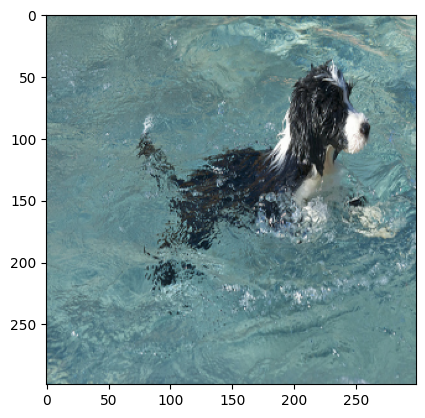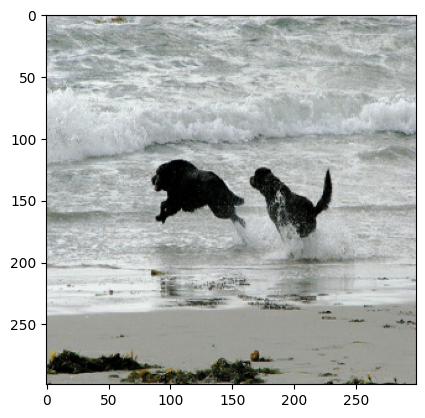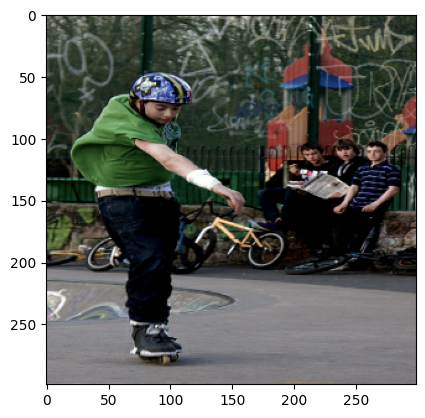无
图像字幕生成
作者: A_K_Nain
创建日期 2021/05/29
最后修改日期 2021/10/31
描述: 使用CNN和Transformer实现图像字幕生成模型。
设置
import os
os.environ["KERAS_BACKEND"] = "tensorflow"
import re
import numpy as np
import matplotlib.pyplot as plt
import tensorflow as tf
import keras
from keras import layers
from keras.applications import efficientnet
from keras.layers import TextVectorization
keras.utils.set_random_seed(111)
下载数据集
本教程将使用Flickr8K数据集。该数据集包含8000多张图片,每张图片都配有五种不同的字幕。
!wget -q https://github.com/jbrownlee/Datasets/releases/download/Flickr8k/Flickr8k_Dataset.zip
!wget -q https://github.com/jbrownlee/Datasets/releases/download/Flickr8k/Flickr8k_text.zip
!unzip -qq Flickr8k_Dataset.zip
!unzip -qq Flickr8k_text.zip
!rm Flickr8k_Dataset.zip Flickr8k_text.zip
# Path to the images
IMAGES_PATH = "Flicker8k_Dataset"
# Desired image dimensions
IMAGE_SIZE = (299, 299)
# Vocabulary size
VOCAB_SIZE = 10000
# Fixed length allowed for any sequence
SEQ_LENGTH = 25
# Dimension for the image embeddings and token embeddings
EMBED_DIM = 512
# Per-layer units in the feed-forward network
FF_DIM = 512
# Other training parameters
BATCH_SIZE = 64
EPOCHS = 30
AUTOTUNE = tf.data.AUTOTUNE
准备数据集
def load_captions_data(filename):
"""Loads captions (text) data and maps them to corresponding images.
Args:
filename: Path to the text file containing caption data.
Returns:
caption_mapping: Dictionary mapping image names and the corresponding captions
text_data: List containing all the available captions
"""
with open(filename) as caption_file:
caption_data = caption_file.readlines()
caption_mapping = {}
text_data = []
images_to_skip = set()
for line in caption_data:
line = line.rstrip("\n")
# Image name and captions are separated using a tab
img_name, caption = line.split("\t")
# Each image is repeated five times for the five different captions.
# Each image name has a suffix `#(caption_number)`
img_name = img_name.split("#")[0]
img_name = os.path.join(IMAGES_PATH, img_name.strip())
# We will remove caption that are either too short to too long
tokens = caption.strip().split()
if len(tokens) < 5 or len(tokens) > SEQ_LENGTH:
images_to_skip.add(img_name)
continue
if img_name.endswith("jpg") and img_name not in images_to_skip:
# We will add a start and an end token to each caption
caption = "<start> " + caption.strip() + " <end>"
text_data.append(caption)
if img_name in caption_mapping:
caption_mapping[img_name].append(caption)
else:
caption_mapping[img_name] = [caption]
for img_name in images_to_skip:
if img_name in caption_mapping:
del caption_mapping[img_name]
return caption_mapping, text_data
def train_val_split(caption_data, train_size=0.8, shuffle=True):
"""Split the captioning dataset into train and validation sets.
Args:
caption_data (dict): Dictionary containing the mapped caption data
train_size (float): Fraction of all the full dataset to use as training data
shuffle (bool): Whether to shuffle the dataset before splitting
Returns:
Traning and validation datasets as two separated dicts
"""
# 1. Get the list of all image names
all_images = list(caption_data.keys())
# 2. Shuffle if necessary
if shuffle:
np.random.shuffle(all_images)
# 3. Split into training and validation sets
train_size = int(len(caption_data) * train_size)
training_data = {
img_name: caption_data[img_name] for img_name in all_images[:train_size]
}
validation_data = {
img_name: caption_data[img_name] for img_name in all_images[train_size:]
}
# 4. Return the splits
return training_data, validation_data
# Load the dataset
captions_mapping, text_data = load_captions_data("Flickr8k.token.txt")
# Split the dataset into training and validation sets
train_data, valid_data = train_val_split(captions_mapping)
print("Number of training samples: ", len(train_data))
print("Number of validation samples: ", len(valid_data))
Number of training samples: 6114
Number of validation samples: 1529
文本数据的向量化
我们将使用TextVectorization层对文本数据进行向量化,即将其转化为整数序列,其中每个整数代表词汇表中单词的索引。我们将使用自定义的字符串标准化方案(去除标点符号,但保留<和>)以及默认的分割方案(按空格分割)。
def custom_standardization(input_string):
lowercase = tf.strings.lower(input_string)
return tf.strings.regex_replace(lowercase, "[%s]" % re.escape(strip_chars), "")
strip_chars = "!\"#$%&'()*+,-./:;<=>?@[\]^_`{|}~"
strip_chars = strip_chars.replace("<", "")
strip_chars = strip_chars.replace(">", "")
vectorization = TextVectorization(
max_tokens=VOCAB_SIZE,
output_mode="int",
output_sequence_length=SEQ_LENGTH,
standardize=custom_standardization,
)
vectorization.adapt(text_data)
# Data augmentation for image data
image_augmentation = keras.Sequential(
[
layers.RandomFlip("horizontal"),
layers.RandomRotation(0.2),
layers.RandomContrast(0.3),
]
)
构建用于训练的tf.data.Dataset管道
我们将使用tf.data.Dataset对象生成图像和对应字幕的配对。该管道包含两个步骤:
- 从磁盘读取图像
- 对图像对应的所有五种字幕进行分词
def decode_and_resize(img_path):
img = tf.io.read_file(img_path)
img = tf.image.decode_jpeg(img, channels=3)
img = tf.image.resize(img, IMAGE_SIZE)
img = tf.image.convert_image_dtype(img, tf.float32)
return img
def process_input(img_path, captions):
return decode_and_resize(img_path), vectorization(captions)
def make_dataset(images, captions):
dataset = tf.data.Dataset.from_tensor_slices((images, captions))
dataset = dataset.shuffle(BATCH_SIZE * 8)
dataset = dataset.map(process_input, num_parallel_calls=AUTOTUNE)
dataset = dataset.batch(BATCH_SIZE).prefetch(AUTOTUNE)
return dataset
# Pass the list of images and the list of corresponding captions
train_dataset = make_dataset(list(train_data.keys()), list(train_data.values()))
valid_dataset = make_dataset(list(valid_data.keys()), list(valid_data.values()))
构建模型
我们的图像字幕生成架构由三个模型组成:
- 一个CNN:用于提取图像特征
- 一个TransformerEncoder:提取的图像特征随后被传递给一个基于Transformer的编码器,该编码器生成输入的新表示。
- 一个TransformerDecoder:该模型以编码器输出和文本数据(序列)为输入,并尝试学习生成字幕。
def get_cnn_model():
base_model = efficientnet.EfficientNetB0(
input_shape=(*IMAGE_SIZE, 3),
include_top=False,
weights="imagenet",
)
# We freeze our feature extractor
base_model.trainable = False
base_model_out = base_model.output
base_model_out = layers.Reshape((-1, base_model_out.shape[-1]))(base_model_out)
cnn_model = keras.models.Model(base_model.input, base_model_out)
return cnn_model
class TransformerEncoderBlock(layers.Layer):
def __init__(self, embed_dim, dense_dim, num_heads, **kwargs):
super().__init__(**kwargs)
self.embed_dim = embed_dim
self.dense_dim = dense_dim
self.num_heads = num_heads
self.attention_1 = layers.MultiHeadAttention(
num_heads=num_heads, key_dim=embed_dim, dropout=0.0
)
self.layernorm_1 = layers.LayerNormalization()
self.layernorm_2 = layers.LayerNormalization()
self.dense_1 = layers.Dense(embed_dim, activation="relu")
def call(self, inputs, training, mask=None):
inputs = self.layernorm_1(inputs)
inputs = self.dense_1(inputs)
attention_output_1 = self.attention_1(
query=inputs,
value=inputs,
key=inputs,
attention_mask=None,
training=training,
)
out_1 = self.layernorm_2(inputs + attention_output_1)
return out_1
class PositionalEmbedding(layers.Layer):
def __init__(self, sequence_length, vocab_size, embed_dim, **kwargs):
super().__init__(**kwargs)
self.token_embeddings = layers.Embedding(
input_dim=vocab_size, output_dim=embed_dim
)
self.position_embeddings = layers.Embedding(
input_dim=sequence_length, output_dim=embed_dim
)
self.sequence_length = sequence_length
self.vocab_size = vocab_size
self.embed_dim = embed_dim
self.embed_scale = tf.math.sqrt(tf.cast(embed_dim, tf.float32))
def call(self, inputs):
length = tf.shape(inputs)[-1]
positions = tf.range(start=0, limit=length, delta=1)
embedded_tokens = self.token_embeddings(inputs)
embedded_tokens = embedded_tokens * self.embed_scale
embedded_positions = self.position_embeddings(positions)
return embedded_tokens + embedded_positions
def compute_mask(self, inputs, mask=None):
return tf.math.not_equal(inputs, 0)
class TransformerDecoderBlock(layers.Layer):
def __init__(self, embed_dim, ff_dim, num_heads, **kwargs):
super().__init__(**kwargs)
self.embed_dim = embed_dim
self.ff_dim = ff_dim
self.num_heads = num_heads
self.attention_1 = layers.MultiHeadAttention(
num_heads=num_heads, key_dim=embed_dim, dropout=0.1
)
self.attention_2 = layers.MultiHeadAttention(
num_heads=num_heads, key_dim=embed_dim, dropout=0.1
)
self.ffn_layer_1 = layers.Dense(ff_dim, activation="relu")
self.ffn_layer_2 = layers.Dense(embed_dim)
self.layernorm_1 = layers.LayerNormalization()
self.layernorm_2 = layers.LayerNormalization()
self.layernorm_3 = layers.LayerNormalization()
self.embedding = PositionalEmbedding(
embed_dim=EMBED_DIM,
sequence_length=SEQ_LENGTH,
vocab_size=VOCAB_SIZE,
)
self.out = layers.Dense(VOCAB_SIZE, activation="softmax")
self.dropout_1 = layers.Dropout(0.3)
self.dropout_2 = layers.Dropout(0.5)
self.supports_masking = True
def call(self, inputs, encoder_outputs, training, mask=None):
inputs = self.embedding(inputs)
causal_mask = self.get_causal_attention_mask(inputs)
if mask is not None:
padding_mask = tf.cast(mask[:, :, tf.newaxis], dtype=tf.int32)
combined_mask = tf.cast(mask[:, tf.newaxis, :], dtype=tf.int32)
combined_mask = tf.minimum(combined_mask, causal_mask)
attention_output_1 = self.attention_1(
query=inputs,
value=inputs,
key=inputs,
attention_mask=combined_mask,
training=training,
)
out_1 = self.layernorm_1(inputs + attention_output_1)
attention_output_2 = self.attention_2(
query=out_1,
value=encoder_outputs,
key=encoder_outputs,
attention_mask=padding_mask,
training=training,
)
out_2 = self.layernorm_2(out_1 + attention_output_2)
ffn_out = self.ffn_layer_1(out_2)
ffn_out = self.dropout_1(ffn_out, training=training)
ffn_out = self.ffn_layer_2(ffn_out)
ffn_out = self.layernorm_3(ffn_out + out_2, training=training)
ffn_out = self.dropout_2(ffn_out, training=training)
preds = self.out(ffn_out)
return preds
def get_causal_attention_mask(self, inputs):
input_shape = tf.shape(inputs)
batch_size, sequence_length = input_shape[0], input_shape[1]
i = tf.range(sequence_length)[:, tf.newaxis]
j = tf.range(sequence_length)
mask = tf.cast(i >= j, dtype="int32")
mask = tf.reshape(mask, (1, input_shape[1], input_shape[1]))
mult = tf.concat(
[
tf.expand_dims(batch_size, -1),
tf.constant([1, 1], dtype=tf.int32),
],
axis=0,
)
return tf.tile(mask, mult)
class ImageCaptioningModel(keras.Model):
def __init__(
self,
cnn_model,
encoder,
decoder,
num_captions_per_image=5,
image_aug=None,
):
super().__init__()
self.cnn_model = cnn_model
self.encoder = encoder
self.decoder = decoder
self.loss_tracker = keras.metrics.Mean(name="loss")
self.acc_tracker = keras.metrics.Mean(name="accuracy")
self.num_captions_per_image = num_captions_per_image
self.image_aug = image_aug
def calculate_loss(self, y_true, y_pred, mask):
loss = self.loss(y_true, y_pred)
mask = tf.cast(mask, dtype=loss.dtype)
loss *= mask
return tf.reduce_sum(loss) / tf.reduce_sum(mask)
def calculate_accuracy(self, y_true, y_pred, mask):
accuracy = tf.equal(y_true, tf.argmax(y_pred, axis=2))
accuracy = tf.math.logical_and(mask, accuracy)
accuracy = tf.cast(accuracy, dtype=tf.float32)
mask = tf.cast(mask, dtype=tf.float32)
return tf.reduce_sum(accuracy) / tf.reduce_sum(mask)
def _compute_caption_loss_and_acc(self, img_embed, batch_seq, training=True):
encoder_out = self.encoder(img_embed, training=training)
batch_seq_inp = batch_seq[:, :-1]
batch_seq_true = batch_seq[:, 1:]
mask = tf.math.not_equal(batch_seq_true, 0)
batch_seq_pred = self.decoder(
batch_seq_inp, encoder_out, training=training, mask=mask
)
loss = self.calculate_loss(batch_seq_true, batch_seq_pred, mask)
acc = self.calculate_accuracy(batch_seq_true, batch_seq_pred, mask)
return loss, acc
def train_step(self, batch_data):
batch_img, batch_seq = batch_data
batch_loss = 0
batch_acc = 0
if self.image_aug:
batch_img = self.image_aug(batch_img)
# 1. Get image embeddings
img_embed = self.cnn_model(batch_img)
# 2. Pass each of the five captions one by one to the decoder
# along with the encoder outputs and compute the loss as well as accuracy
# for each caption.
for i in range(self.num_captions_per_image):
with tf.GradientTape() as tape:
loss, acc = self._compute_caption_loss_and_acc(
img_embed, batch_seq[:, i, :], training=True
)
# 3. Update loss and accuracy
batch_loss += loss
batch_acc += acc
# 4. Get the list of all the trainable weights
train_vars = (
self.encoder.trainable_variables + self.decoder.trainable_variables
)
# 5. Get the gradients
grads = tape.gradient(loss, train_vars)
# 6. Update the trainable weights
self.optimizer.apply_gradients(zip(grads, train_vars))
# 7. Update the trackers
batch_acc /= float(self.num_captions_per_image)
self.loss_tracker.update_state(batch_loss)
self.acc_tracker.update_state(batch_acc)
# 8. Return the loss and accuracy values
return {
"loss": self.loss_tracker.result(),
"acc": self.acc_tracker.result(),
}
def test_step(self, batch_data):
batch_img, batch_seq = batch_data
batch_loss = 0
batch_acc = 0
# 1. Get image embeddings
img_embed = self.cnn_model(batch_img)
# 2. Pass each of the five captions one by one to the decoder
# along with the encoder outputs and compute the loss as well as accuracy
# for each caption.
for i in range(self.num_captions_per_image):
loss, acc = self._compute_caption_loss_and_acc(
img_embed, batch_seq[:, i, :], training=False
)
# 3. Update batch loss and batch accuracy
batch_loss += loss
batch_acc += acc
batch_acc /= float(self.num_captions_per_image)
# 4. Update the trackers
self.loss_tracker.update_state(batch_loss)
self.acc_tracker.update_state(batch_acc)
# 5. Return the loss and accuracy values
return {
"loss": self.loss_tracker.result(),
"acc": self.acc_tracker.result(),
}
@property
def metrics(self):
# We need to list our metrics here so the `reset_states()` can be
# called automatically.
return [self.loss_tracker, self.acc_tracker]
cnn_model = get_cnn_model()
encoder = TransformerEncoderBlock(embed_dim=EMBED_DIM, dense_dim=FF_DIM, num_heads=1)
decoder = TransformerDecoderBlock(embed_dim=EMBED_DIM, ff_dim=FF_DIM, num_heads=2)
caption_model = ImageCaptioningModel(
cnn_model=cnn_model,
encoder=encoder,
decoder=decoder,
image_aug=image_augmentation,
)
模型训练
# Define the loss function
cross_entropy = keras.losses.SparseCategoricalCrossentropy(
from_logits=False,
reduction=None,
)
# EarlyStopping criteria
early_stopping = keras.callbacks.EarlyStopping(patience=3, restore_best_weights=True)
# Learning Rate Scheduler for the optimizer
class LRSchedule(keras.optimizers.schedules.LearningRateSchedule):
def __init__(self, post_warmup_learning_rate, warmup_steps):
super().__init__()
self.post_warmup_learning_rate = post_warmup_learning_rate
self.warmup_steps = warmup_steps
def __call__(self, step):
global_step = tf.cast(step, tf.float32)
warmup_steps = tf.cast(self.warmup_steps, tf.float32)
warmup_progress = global_step / warmup_steps
warmup_learning_rate = self.post_warmup_learning_rate * warmup_progress
return tf.cond(
global_step < warmup_steps,
lambda: warmup_learning_rate,
lambda: self.post_warmup_learning_rate,
)
# Create a learning rate schedule
num_train_steps = len(train_dataset) * EPOCHS
num_warmup_steps = num_train_steps // 15
lr_schedule = LRSchedule(post_warmup_learning_rate=1e-4, warmup_steps=num_warmup_steps)
# Compile the model
caption_model.compile(optimizer=keras.optimizers.Adam(lr_schedule), loss=cross_entropy)
# Fit the model
caption_model.fit(
train_dataset,
epochs=EPOCHS,
validation_data=valid_dataset,
callbacks=[early_stopping],
)
Epoch 1/30
/opt/conda/envs/keras-tensorflow/lib/python3.10/site-packages/keras/src/layers/layer.py:861: UserWarning: Layer 'query' (of type EinsumDense) was passed an input with a mask attached to it. However, this layer does not support masking and will therefore destroy the mask information. Downstream layers will not see the mask.
warnings.warn(
/opt/conda/envs/keras-tensorflow/lib/python3.10/site-packages/keras/src/layers/layer.py:861: UserWarning: Layer 'key' (of type EinsumDense) was passed an input with a mask attached to it. However, this layer does not support masking and will therefore destroy the mask information. Downstream layers will not see the mask.
warnings.warn(
/opt/conda/envs/keras-tensorflow/lib/python3.10/site-packages/keras/src/layers/layer.py:861: UserWarning: Layer 'value' (of type EinsumDense) was passed an input with a mask attached to it. However, this layer does not support masking and will therefore destroy the mask information. Downstream layers will not see the mask.
warnings.warn(
96/96 ━━━━━━━━━━━━━━━━━━━━ 91s 477ms/step - acc: 0.1324 - loss: 35.2713 - accuracy: 0.2120 - val_accuracy: 0.3117 - val_loss: 20.4337
Epoch 2/30
96/96 ━━━━━━━━━━━━━━━━━━━━ 38s 398ms/step - acc: 0.3203 - loss: 19.9756 - accuracy: 0.3300 - val_accuracy: 0.3517 - val_loss: 18.0001
Epoch 3/30
96/96 ━━━━━━━━━━━━━━━━━━━━ 38s 394ms/step - acc: 0.3533 - loss: 17.7575 - accuracy: 0.3586 - val_accuracy: 0.3694 - val_loss: 16.9179
Epoch 4/30
96/96 ━━━━━━━━━━━━━━━━━━━━ 38s 396ms/step - acc: 0.3721 - loss: 16.6177 - accuracy: 0.3750 - val_accuracy: 0.3781 - val_loss: 16.3415
Epoch 5/30
96/96 ━━━━━━━━━━━━━━━━━━━━ 38s 394ms/step - acc: 0.3840 - loss: 15.8190 - accuracy: 0.3872 - val_accuracy: 0.3876 - val_loss: 15.8820
Epoch 6/30
96/96 ━━━━━━━━━━━━━━━━━━━━ 37s 390ms/step - acc: 0.3959 - loss: 15.1802 - accuracy: 0.3973 - val_accuracy: 0.3933 - val_loss: 15.6454
Epoch 7/30
96/96 ━━━━━━━━━━━━━━━━━━━━ 38s 395ms/step - acc: 0.4035 - loss: 14.7098 - accuracy: 0.4054 - val_accuracy: 0.3956 - val_loss: 15.4308
Epoch 8/30
96/96 ━━━━━━━━━━━━━━━━━━━━ 38s 394ms/step - acc: 0.4128 - loss: 14.2644 - accuracy: 0.4128 - val_accuracy: 0.4001 - val_loss: 15.2675
Epoch 9/30
96/96 ━━━━━━━━━━━━━━━━━━━━ 38s 393ms/step - acc: 0.4180 - loss: 13.9154 - accuracy: 0.4196 - val_accuracy: 0.4034 - val_loss: 15.1764
Epoch 10/30
96/96 ━━━━━━━━━━━━━━━━━━━━ 37s 390ms/step - acc: 0.4256 - loss: 13.5624 - accuracy: 0.4261 - val_accuracy: 0.4040 - val_loss: 15.1567
Epoch 11/30
96/96 ━━━━━━━━━━━━━━━━━━━━ 38s 393ms/step - acc: 0.4310 - loss: 13.2789 - accuracy: 0.4325 - val_accuracy: 0.4053 - val_loss: 15.0365
Epoch 12/30
96/96 ━━━━━━━━━━━━━━━━━━━━ 38s 399ms/step - acc: 0.4366 - loss: 13.0339 - accuracy: 0.4371 - val_accuracy: 0.4084 - val_loss: 15.0476
Epoch 13/30
96/96 ━━━━━━━━━━━━━━━━━━━━ 38s 392ms/step - acc: 0.4417 - loss: 12.7608 - accuracy: 0.4432 - val_accuracy: 0.4090 - val_loss: 15.0246
Epoch 14/30
96/96 ━━━━━━━━━━━━━━━━━━━━ 38s 391ms/step - acc: 0.4481 - loss: 12.5039 - accuracy: 0.4485 - val_accuracy: 0.4083 - val_loss: 14.9793
Epoch 15/30
96/96 ━━━━━━━━━━━━━━━━━━━━ 38s 391ms/step - acc: 0.4533 - loss: 12.2946 - accuracy: 0.4542 - val_accuracy: 0.4109 - val_loss: 15.0170
Epoch 16/30
96/96 ━━━━━━━━━━━━━━━━━━━━ 37s 387ms/step - acc: 0.4583 - loss: 12.0837 - accuracy: 0.4588 - val_accuracy: 0.4099 - val_loss: 15.1056
Epoch 17/30
96/96 ━━━━━━━━━━━━━━━━━━━━ 37s 389ms/step - acc: 0.4617 - loss: 11.8657 - accuracy: 0.4624 - val_accuracy: 0.4088 - val_loss: 15.1226
<keras.src.callbacks.history.History at 0x7fcd08887fa0>
检查样本预测
vocab = vectorization.get_vocabulary()
index_lookup = dict(zip(range(len(vocab)), vocab))
max_decoded_sentence_length = SEQ_LENGTH - 1
valid_images = list(valid_data.keys())
def generate_caption():
# Select a random image from the validation dataset
sample_img = np.random.choice(valid_images)
# Read the image from the disk
sample_img = decode_and_resize(sample_img)
img = sample_img.numpy().clip(0, 255).astype(np.uint8)
plt.imshow(img)
plt.show()
# Pass the image to the CNN
img = tf.expand_dims(sample_img, 0)
img = caption_model.cnn_model(img)
# Pass the image features to the Transformer encoder
encoded_img = caption_model.encoder(img, training=False)
# Generate the caption using the Transformer decoder
decoded_caption = "<start> "
for i in range(max_decoded_sentence_length):
tokenized_caption = vectorization([decoded_caption])[:, :-1]
mask = tf.math.not_equal(tokenized_caption, 0)
predictions = caption_model.decoder(
tokenized_caption, encoded_img, training=False, mask=mask
)
sampled_token_index = np.argmax(predictions[0, i, :])
sampled_token = index_lookup[sampled_token_index]
if sampled_token == "<end>":
break
decoded_caption += " " + sampled_token
decoded_caption = decoded_caption.replace("<start> ", "")
decoded_caption = decoded_caption.replace(" <end>", "").strip()
print("Predicted Caption: ", decoded_caption)
# Check predictions for a few samples
generate_caption()
generate_caption()
generate_caption()

Predicted Caption: a black and white dog is swimming in a pool

Predicted Caption: a black dog is running through the water

Predicted Caption: a man in a green shirt and green pants is riding a bicycle
结束语
我们发现模型在经过几个epoch后就开始生成合理的字幕。为了使本示例易于运行,我们对其进行了一些限制,例如最小注意力头数。为了改进预测,您可以尝试更改这些训练设置,为您的用例找到一个好模型。